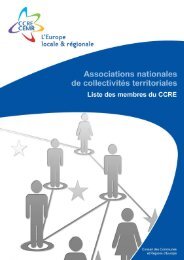COMPLEMENTARITIES BETWEEN URBAN AND RURAL AREAS IN PROMOTING EMPLOYMENT AND SOCIAL INCLUSIONbeh<strong>in</strong>d this concept was to establish the partnershipdur<strong>in</strong>g these six months <strong>in</strong> order todevelop a jo<strong>in</strong>t strategy, to mutually def<strong>in</strong>e thenature of the problem, <strong>and</strong> to assess whatoptions for solutions <strong>and</strong> resources exist <strong>and</strong>how they can be mobilised. The first <strong>in</strong>stance ofthis process was undertaken <strong>between</strong> November2001 <strong>and</strong> May 2002.EQUAL is built on the pr<strong>in</strong>ciples of transnationality,partnership <strong>and</strong> empowerment. In additionthere is also the pr<strong>in</strong>ciple of <strong>in</strong>novation whichmeans that one has to f<strong>in</strong>d new ways of organis<strong>in</strong>g<strong>and</strong> connect<strong>in</strong>g work with other aspects oflife: a new means of work<strong>in</strong>g which facilitates abalance <strong>between</strong> family life, leisure, tra<strong>in</strong><strong>in</strong>g <strong>and</strong>work is be<strong>in</strong>g <strong>in</strong>itiated. F<strong>in</strong>ally an important elementthat has to be <strong>in</strong>tegrated from the beg<strong>in</strong>n<strong>in</strong>gis ma<strong>in</strong>stream<strong>in</strong>g, that is to say the <strong>in</strong>tegrationof what has been learnt should be put<strong>in</strong>to practice at every level. Under ADAPT, therewere a number of projects <strong>in</strong> the field of jobrotation. This was first developed <strong>in</strong> Denmarkwhere unemployed people are recruited for alimited period of time to work <strong>in</strong> companies, ona temporary basis, to replace exist<strong>in</strong>g staff whowere be<strong>in</strong>g tra<strong>in</strong>ed. This aga<strong>in</strong> is an <strong>in</strong>terface ofhow to comb<strong>in</strong>e those <strong>in</strong>stitutions deal<strong>in</strong>g withunemployed people <strong>and</strong> those <strong>in</strong>stitutions thatdeal with tra<strong>in</strong><strong>in</strong>g, as well as how to f<strong>in</strong>d fund<strong>in</strong>garrangements comb<strong>in</strong><strong>in</strong>g the two. Differenttypes of models have been applied to small companies,large companies, <strong>and</strong> to <strong>urban</strong>ised <strong>rural</strong><strong>areas</strong>. These experiments have been successfulwhere they have found a way to validate theresults <strong>and</strong> discovered an approach to overcom<strong>in</strong>gthe obstacles <strong>in</strong> the current legislativeregime. In some member states, platforms <strong>and</strong>associations were formed to lobby parliamentarians.This <strong>in</strong> turn resulted <strong>in</strong> new legislation, forexample <strong>in</strong> Portugal, Italy <strong>and</strong> Germany.WHAT HAS BEEN ACHIEVED SO FAR?In the first round of the EQUAL <strong>in</strong>itiative, memberstates who implement this programme haveselected 1,500 development partnerships <strong>in</strong> n<strong>in</strong>ethematic fields which were agreed upon bymember states as be<strong>in</strong>g problem <strong>areas</strong> where itis necessary to cooperate <strong>and</strong> to learn from oneanother. Between November 2001 <strong>and</strong> spr<strong>in</strong>g2002, 1,500 development partnerships havebeen established. They have developed a strategy<strong>and</strong> have agreed on a work plan that commits allpartners for the next two years. Thematicallyspeak<strong>in</strong>g, there is a concentration on the facilitationof access to the labour market, especiallyfor the long-term unemployed. More than halfof these partnerships are regional or local partnerships,which means that they all work <strong>in</strong> thesame region <strong>and</strong> they tackle a specific problemthat is evident <strong>in</strong> one of these regions. Approximatelyten partners work together <strong>in</strong> each of thepartnerships <strong>and</strong> most of them <strong>in</strong>clude a local orregional authority, one or more have strategic oroperational partners, <strong>and</strong> a number of them havemanaged to <strong>in</strong>clude NGOs. In addition, platformshave been set up for the validation of experience<strong>and</strong> for the identification of good practice alreadyimplemented. It is <strong>in</strong>tended that European networks,where the coord<strong>in</strong>ators of the partnershipsmeet organisations work<strong>in</strong>g at Europeanlevel, work together on a number of specificissues which are relevant to the political agenda.These platforms are also <strong>in</strong>tended to provide anexchange of best practice. Different memberstates have different experiences. Some of themare outside EQUAL <strong>and</strong> the Commission is try<strong>in</strong>gto <strong>in</strong>tegrate these <strong>in</strong> order to facilitate progress.It should not be forgotten that although EQUALrepresents only 5 percent of the European StructuralFund <strong>in</strong> absolute terms, this programmeaccounts for around 3 billion euro. Complementarynational fund<strong>in</strong>g also exists.— 20 —
COMPLEMENTARITIES BETWEEN URBAN AND RURAL AREAS IN PROMOTING EMPLOYMENT AND SOCIAL INCLUSIONSESSION 3Partnerships, network<strong>in</strong>g <strong>and</strong> project management■ Build<strong>in</strong>g <strong>and</strong> driv<strong>in</strong>g partnerships: how does it work? “The Essex Experience”Paul Williams, Essex Rural Partnership●●Traditionally, it has been difficult to organisecooperation <strong>between</strong> different levels of government.One of the achievements of the partnership<strong>in</strong> Essex is that it br<strong>in</strong>gs together technicalexperts from local <strong>and</strong> regional levels. In addition,the end customer is present <strong>in</strong> these discussions.If, for example, a member of theagricultural community has difficulties <strong>in</strong> diversify<strong>in</strong>ghis farm<strong>in</strong>g <strong>in</strong>terests ie. mov<strong>in</strong>g fromproduction to tourism, technical experts areavailable to discuss the problems he is fac<strong>in</strong>g.With<strong>in</strong> this partnership, representatives of allregional bodies of national agencies are <strong>in</strong>cluded,e.g. the Government Office of the EasternRegion, the Department of Environment, Food<strong>and</strong> Rural Affairs (DEFRA), the CountrysideAgency East of Engl<strong>and</strong> Development Agency,<strong>and</strong> the Environment Agency.Each district <strong>and</strong> borough <strong>in</strong> Essex has its ownforum for discuss<strong>in</strong>g <strong>rural</strong> development. Infor-●mation from these forums is fed <strong>in</strong>to a largerpartnership with Essex County Council. At thevillage <strong>and</strong> town levels, parish <strong>and</strong> town councilsserve as a means by which the general publiccan be <strong>in</strong>volved. This is a mechanism throughwhich Essex Rural Partnership can provide <strong>in</strong>putfrom the local level to national government. Forexample, <strong>in</strong>formation is distributed upwardsfrom towns <strong>and</strong> parishes, through districts <strong>and</strong>the county level to a regional <strong>rural</strong> affairs forum.This forum, <strong>in</strong> turn, presents the <strong>in</strong>formation toa national forum, which provides <strong>in</strong>put togovernment policy.One of the key aspects of the success of <strong>rural</strong>partnership <strong>in</strong> Essex is publicity. It is also importantto have local <strong>rural</strong> <strong>in</strong>formation po<strong>in</strong>ts todistribute <strong>in</strong>formation. Furthermore, events orcampaigns, organised <strong>in</strong> connection with otheractors from either the private or public sectors,can help to create better publicity.■ The partnership <strong>in</strong> the LEADER <strong>rural</strong> development programmeCather<strong>in</strong>e de Borchgrave, European Association for Information on Local Development (AEIDL)The AEIDL (European Association for Informationon Local Development) has been ma<strong>in</strong>ly work<strong>in</strong>gon the LEADER programme, for which partnershipis an essential concept. LEADER I was a pilotprogramme launched by the Commission <strong>in</strong> 1991<strong>and</strong> cover<strong>in</strong>g 217 territories, ma<strong>in</strong>ly <strong>in</strong> objectives1 <strong>and</strong> 5b <strong>areas</strong>. LEADER II generalised this programmefrom 1994 onwards, cover<strong>in</strong>g more than1,000 territories <strong>in</strong> objectives 1, 5b <strong>and</strong> 6 <strong>areas</strong>.One of the ma<strong>in</strong> features of the LEADER programmesis the <strong>in</strong>strument of partnerships, br<strong>in</strong>g<strong>in</strong>gtogether different social <strong>and</strong> economicpartners.The LEADER+ <strong>in</strong>itiative is based on 7 aspects:1. area-based approach (area of less than100,000 <strong>in</strong>habitants, which has excluded theparticipation of medium-cities with whichsome <strong>rural</strong>-<strong>urban</strong> partnerships could havebeen developed);2. bottom-up approach;3. partnership approach <strong>and</strong> <strong>in</strong>tervention formanagement <strong>and</strong> animation of a local actiongroup (LAG);4. <strong>in</strong>novation;5. <strong>in</strong>tegrated multisectoral approach;6. network<strong>in</strong>g <strong>and</strong> co-operation;7. local f<strong>in</strong>anc<strong>in</strong>g <strong>and</strong> management.— 21 —


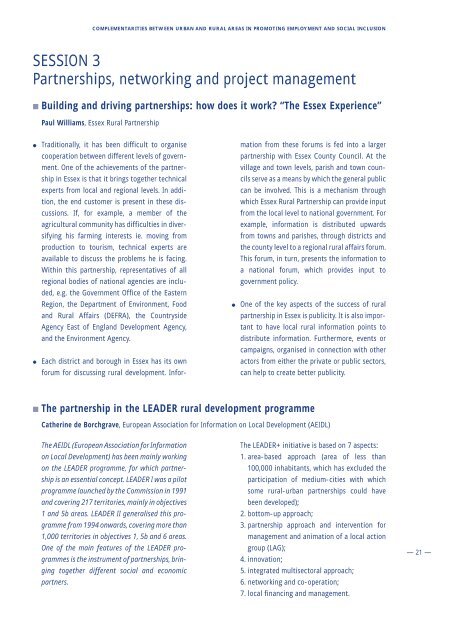
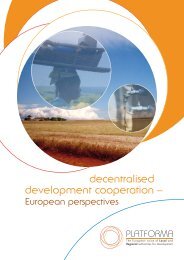

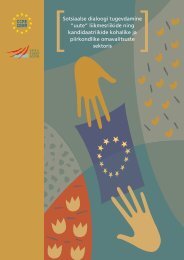
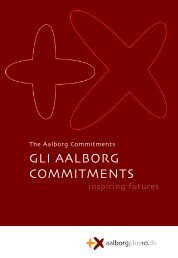





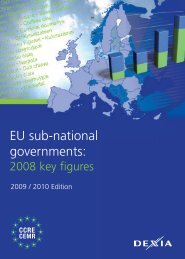
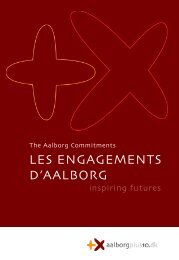
![[ ] Les jumelages pour le monde de demain](https://img.yumpu.com/29721946/1/190x96/-les-jumelages-pour-le-monde-de-demain.jpg?quality=85)

